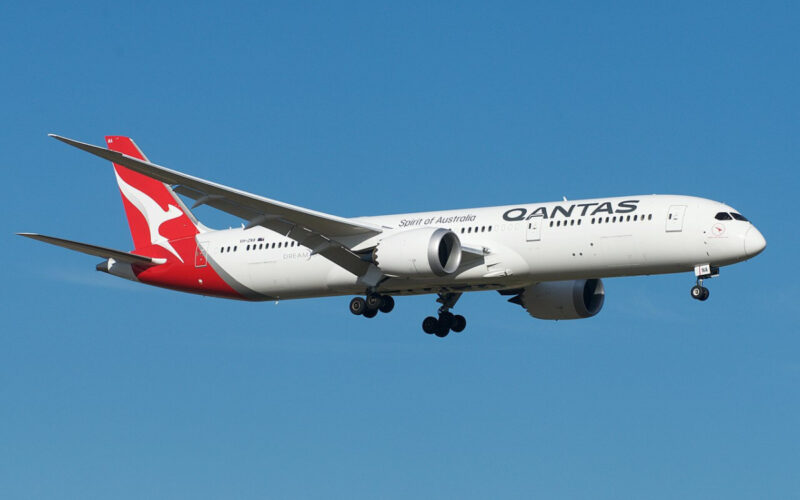Updated 05-06-2019 12:50 (UTC+2).
Major airlines around the globe are pushing the limits and capabilities of next-generation aircraft by increasingly targeting long-haul and super-haul flights across continents. One such ambitious project is underway for Qantas – Australia’s national carrier is expecting Airbus and Boeing to present their final offers for the ultra-long-haul aircraft that would be operated on the planned Sydney-London route, set to be the world’s longest commercial flight when it is launched in 2023. The ultra-comfortable passenger experience boasted about by the airline’s CEO, on the other hand, may not come to fruition.
Last year, on May 24th, Qantas launched what it hailed as “historic” non-stop service between Perth and London. The over 9,000 mile (14,500 km) flight operated by Boeing 787-9 Dreamliner took just over 17 hours to complete. But this service was just a warm-up before the airline rolls-out direct flights from Sydney to London and New York.
In 2017, Qantas’ CEO Alan Joyce announced the airline is targeting direct flights from the east coast of Australia to the two major cities by 2022, Bloomberg reported at the time. It was planned that the Sydney-London service would take 20 hours, 20 minutes, while the Sydney-New York route would be covered in 18 hours, 7 minutes.
Other possible routes envisioned at the time included Paris, Rio de Janeiro and Cape Town, linking Australia directly to hubs in the Americas, Europe and Africa.
To make the super-haul flight viable, Joyce turned to the world’s leading aircraft manufacturers – Airbus and Boeing. Latest report from Aviator.aero indicates the airline has asked the plane makers to present their “best and final offer” for long-haul jetliners that would be capable of flying the up to 21-hour, over 10,550 mile (16,979 km) -long non-stop flight between Sydney to London by August 2019.
The choice is between the ultra-long-range Airbus A350 and the Boeing 777X, various media sources indicate; and if “everything else comes together”, the final decision to place an order would be made by the end of the year, Joyce told CNBC.
As is the case, the main challenge for the plane makers is range and capability: the manufacturer would have to configure a jetliner that could fly about 300 passengers farther than any regular service to date. For instance, Qantas’ Boeing 787-9, operating on the Perth-London route, is configured with a total seat count of 236 passengers.
“Farther” also means beating Singapore Airlines (SIA1) (SINGY) (SIA), which made headlines last year when it re-launched its non-stop Singapore-New York service, becoming the world’s longest commercial flight today. Launched on October 11, 2018, the inaugural flight lasted 17 hours, 52 minutes covering some 9,500 miles (15,300 km).
SIA’s service is operated by one of the carrier’s Airbus A350-900ULR (Ultra Long Range) jets, a variant of the A350 XWB Family aircraft ordered specifically for such long distance flights. Configured in a two-class layout, the jetliner can seat 161 passengers.
According to Forbes estimations, on average, SIA’s Singapore-New York service covers 9,534 miles taking up to 18 hours, 30 minutes. The introduction of this route dethroned Qatar Airways’ Auckland-Doha service as the world’s longest flight. Operated by Boeing 777-200LR (Long Range) the Qatar Airways’ 9,032 mile-long route takes 17 hours, 50 minutes.
For now, Qantas’ Perth-London service comes at third place, covering 9,009 miles and lasting 17 hours, 25 minutes. This new route, in turn, overtook Emirates’ Dubai-Auckland non-stop flights that spanned 8,824 miles, lasting 17 hours, 10 minutes (operated by Airbus A380).
Project Sunrise
Qantas’s ambitious endeavor, resembling the likes of a space mission or a secret defense project by its name, is called Project Sunrise. Embedded in the project was the enthusiasm to come up with creative ideas to enhance passenger experience on the grueling over 20-hour flight.
Forget all the usual in-flight entertainment – to take it up a notch, Joyce teased installing a gym, bar, underfloor sleeping berths, meeting rooms, as well as child-care facilities, on board the aircraft. According to the latest report by Bloomberg, Qantas may have to tone down talks of these extraordinary enhancements and scrap some of the plans for the interior.
The planes proposed for the Sydney-London and Sydney-New York flights by Airbus and Boeing meet the range capabilities, however, neither can carry the weight that Qantas initially planned (aside from the various facilities and the up to 300 passenger count, the airplane would also have to be able to carry more fuel for unexpected headwinds and emergencies).
Qantas’s CEO is now hinting at new first class and economy class products, keeping the idea for an exercise area and as well as a place for re-hydration that would be offered for both economy and business class passengers, Simple Flying writes.
Still, there are some other hurdles ahead for Project Sunrise: Qantas needs to reach a new agreement with its pilots, who would be subject to longer working hours that the ultra-long-flights will require. The carrier also needs all the necessary regulatory approvals.
As for now, whether the airline picks Airbus or Boeing, the aircraft are expected to be delivered in 2022 and the first flights to commence in 2023, Bloomberg cites Joyce as saying.

